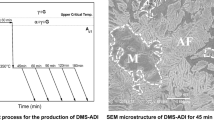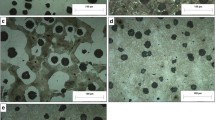Abstract
In the current study, an unalloyed ductile iron containing 3.50 C wt.%, 2.63 Si wt.%, 0.318 Mn wt.%, and 0.047 Mg wt.% was intercritically austenitized (partially austenitized) in two-phase regions (α + γ) at different temperatures for 20 min and then was quenched into salt bath held at austempering temperature of 365 °C for various times to obtain different ausferrite plus proeutectoid ferrite volume fractions. Fine and coarse dual matrix structures (DMS) were obtained from two different starting conditions. Some specimens were also conventionally austempered from 900 °C for comparison. The results showed that a structure having proeutectoid ferrite plus ausferrite (bainitic ferrite + high-carbon austenite (retained or stabilized austenite)) has been developed. Both of the specimens with ∼75% ausferrite volume fraction (coarse structure) and the specimen with ∼82% ausferrite volume fraction (fine structure) exhibited the best combination of high strength and ductility compared to the pearlitic grades, but their ductility is slightly lower than the ferritic grades. These materials also satisfy the requirements for the strength of the quenched and tempered grades and their ductility is superior to this grade. The correlation between the strain-hardening rates of the various austempered ductile iron (ADI) with DMS and conventionally heat-treated ADI microstructures as a function of strain was conducted by inspection of the respective tensile curves. For this purpose, the Crussard-Jaoul (C-J) analysis was employed. The test results also indicate that strain-hardening behavior of ADI with dual matrix is influenced by the variations in the volume fractions of the phases, and their morphologies, the degree of ausferrite connectivity and the interaction intensities between the carbon atoms and the dislocations in the matrix. The ADI with DMS generally exhibited low strain-hardening rates compared to the conventionally ADI.











Similar content being viewed by others
References
J. Yang, S.K. Putatunda (2004) Influence of a Novel Two-Step Austempering Process on the Strain-Hardening Behavior of Austempered Ductile Cast Iron (ADI). Mat. Sci. Eng. A, A382(1–2):265–279, in English
J. Aranzabal, I. Gutierrez, J.M. RodriguezIbabe, J.J. Urcola (1997) Influence of the Amount and Morphology of Retained Austenite on the Mechanical Properties of an Austempered Ductile Iron. Met. Mat. Trans. A 28A(5):1143–1156, in English
R.C. Voigt, L.M. Eldoky, H.S. Chiou (1986) Fracture of Ductile Cast Irons With Dual Matrix Structure. AFS Trans. 94:645–656, in English
A.M. Rashidi, M. Moshrefi-Torbati (2000) Effect of Tempering Conditions on the Mechanical Properties of Ductile Cast Iron with Dual Matrix Structure (DMS). Mat. Let. 45(3–4):203–207, in English
J. Aranzabal, G. Serramoglia, D. Rousiere (2003) Development of a New Mixed (Ferritic-Ausferritic) Ductile Iron for Automotive Suspension Parts. Int. J. Cast. Met. Res. 16(1–3):185–190, in English
T. Kobayashi, H. Yamamoto (1988) Development of High Toughness in Austempered Type Ductile Cast Iron and Evaluation of its Properties. Metall. Mat. Trans. A 19A(2):319–327, in English
T. Kobayashi, S. Yamada (1996) Effect of Holding Time in the (α + γ) Temperature Range on Toughness of Specially Austempered Ductile Iron. Metall. Mat. Trans. A 27A(7):1961–1971, in English
Z.R. He, G.X. Lin, S. Ji (1997) Deformation and Fracture Behaviour of Cast Iron with Optimized Microstructure. Mat. Charac. 38(4–5):251–258, in English
M. Hafiz (2001) Tensile Properties and Fracture of Ferritic SG-Iron having Different-Shell Structure. Z. Metallkd. 92(11):1258–1261, in English
R. Kazerooni, A. Nazarboland, R. Elliot (1997) Use of Austenitising Temperature in Control of Austempering of An Mn-Mo-Cu Alloyed Ductile Iron. Mat. Sci. Tech. 13(12):1007–1015, in English
M. Cerah, K. Kocatepe, M. Erdogan (2005) Influence of Martensite Volume Fraction and Tempering Time on Tensile Properties of Partially Austenitized in the (α + γ) Temperature Range and Quenched + Tempered Ferritic Ductile Iron. J. Mat. Sci. 40(13):3453–3459, in English
M. Erdogan, K. Kocatepe, M. Cerah (2006) Influence of Intercritical Austenitising and Tempering Time and Martensite Volume Fractions on Tensile Properties of Ferritic Ductile Iron with Dual Matrix Structure. Int. J. Cast. Met. Res. 19(4):248–253, in English
K. Kocatepe, M. Cerah, M. Erdogan (2006) The Tensile Fracture Behaviour of Intercritically Annealed and Quenched + Tempered Ferritic Ductile Iron with Dual Matrix Structure. Mat. Design 28(1):172–181, in English
M. Erdogan, V. Kilicli, and B. Demir, Transformation Characteristics of Ductile Iron Austempered from Intercritical Austenitizing Temperature Ranges, J. Mat. Sci., in Press, DOI: 10.1007/s10853-006-1415-7, 2007, in English
V. Kilicli, M. Erdogan (2006) Tensile Properties of Partially Austenitized and Austempered Ductile Irons with Dual Matrix Structures. Mat. Sci. Tech. 22(8):919–928, in English
V. Kilicli, and M. Erdogan, The Effect of Ausferrite Volume Fraction and its Morphology on the Tensile Properties of Partially Austenitized and Austempered Ductile Irons with Dual Matrix Structures, Int. J. Cast. Met. Res. 2006, Submitted, in English
C.R.F. Azevedo, A.A. Garboggini, A.P. Tschipitschin (1993) Effect of Austenite Grain Refinement on Morphology of Product of Bainitic Reaction in Austempered Ductile Iron. Mater. Sci. Tech. 9(8):705–710, in English
C.S. Roberts (1953) Effect of Carbon on the Lattice Parameter of Austenite. Trans. AIME 197:203–204, in English
K.B. Rundman, R.C. Klug (1982) X-ray and Metallographic Study of an Austempered Ductile Cast Iron. AFS Trans. 90:499–508, in English
A.M. Sarosiek, W.S. Owen (1984) Work Hardening of Dual-Phase Steels at Small Plastic Strains. Mater. Sci. Eng. A 66(1):13–34, in English
Z. Fan, H. Mingzhi, S. Deke (1989) The Relationship Between the Strain-Hardening Exponent n and the Microstructure of Metals. Mater. Sci. Eng. A 122(2):211–213, in English
G.S. Huppi, D.K. Matlock, G. Krauss (1980) An Evaluation of the Importance of Epitaxial Ferrite in Dual Phase Steel Structure. Scrip. Met. 14(11):1239–1243, in English
M.D. Geib, D.K. Matlock, G. Krauss (1980) The Effect of Intercritical Annealing Temperature on the Structure of Niobium Microalloyed Dual Phase Steel. Metall. Trans. A 11A(10):1683–1689, in English
R.D. Lawson, D.K. Matlock, and G. Krauss, The Effect of Microstructure on the Deformation Behavior and Mechanical Properties of a Dual-Phase Steel, Fundamentals of Dual-Phase Steels, R.A. Kot and B.L. Bramfitt, Ed., AIME, Warrendale, 1981, p 347–381
M. Erdogan (2002) The Effect of New Ferrite Content on the Tensile Fracture Behaviour of Dual Phase Steels. J. Mat. Sci 37(17):3623–3630, in English
M. Erdogan, R. Priestner (1999) Effect of Epitaxial Ferrite on Yielding and Plastic Flow in Dual Phase Steel in Tension and Compression. Mat. Sci. Tech. 15(11):1273–1284, in English
M. Erdogan, R. Priestner (2002) Effect of Martensite Content, its Dispersion, and Epitaxial Ferrite Content on Bauschinger Behaviour of Dual Phase Steel. Mat. Sci Tech. 18(4):369–376, in English
M. Erdogan (2003) Effect of Austenite Dispersion on Phase Transformation in Dual Phase Steel. Scrip. Mat. 48(5):501–506, in English
V. Franetovic, M.M. Shea, E.F. Ryntz (1987) Transmission Electron Microscopy Study of Austempered Nodular Iron: Influence of Silicon Content, Austenitizing Time and Austempering Temperature. Mater. Sci. Eng. 96:231–245, in English
J.L. Garin, R.L. Mannheim (2003) Strain-induced Martensite in ADI Alloys. J. Mater. Proc. Tech. 143–144:347–351, in English
W.S. Zhou, Q.D. Zhou, S.K. Meng (1993) Lubricated Sliding and Rolling Wear of Austempered Ductile Iron. Wear 162–164(2):696–702, in English
P. Mayr, H. Vetters, and J. Walla, Investigations on the Stress Induced Martensite Formation in Austempered Ductile Cast Iron (ADI), Proc. 2nd Int. Conf. on Austempered Ductile Cast Iron, Geared Research Institute, 1986 (Ann Arbor), p 171–178
J.J. Vuorinen (1986) Strain Hardening Mechanism and Characteristics of Austempered Ductile Iron. AFS Trans. 94:577–588, in English
W.R. Cribb and J.M. Rigsbee, Work-Hardening Behavior and its Relationship to the Microstructure and Mechanical Properties of Dual-Phase Steels, Structure and Properties of Dual-Phase Steel, R.A. Kot and J.W. Morris, Ed., AIME, 1979 (New York), p 91–117
D.K. Matlock, G. Krauss, L.F. Ramos, and G.S. Huppi, A Correlation of Processing Variables with Deformation of Dual-Phase Steels, Structure and Properties of Dual Phase Steels, R.A. Kot and J.W. Morris, Ed., AIME, 1979 (New York), p 62–89
Acknowledgments
The authors wish to acknowledge the financial supports of Gazi University Scientific Research Fund (Project Code 07/2003-41 and 07/2005-25). The author is also indebted to ALFA Casting Company (Ankara, Turkey) for castings and to Ankara Nuclear Research and Education Center (TAEK-ANAEM) for providing X-Ray facilities. My acknowledgements are also extended to the UMIST Manchester Materials Science Centre for the provision of its laboratory facilities and to its staff who have assisted me throughout our study.
Author information
Authors and Affiliations
Corresponding author
Rights and permissions
About this article
Cite this article
Kilicli, V., Erdogan, M. The Strain-Hardening Behavior of Partially Austenitized and the Austempered Ductile Irons with Dual Matrix Structures. J. of Materi Eng and Perform 17, 240–249 (2008). https://doi.org/10.1007/s11665-007-9143-y
Received:
Revised:
Accepted:
Published:
Issue Date:
DOI: https://doi.org/10.1007/s11665-007-9143-y




